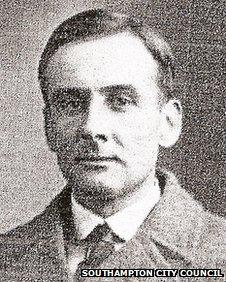Titanic: 'I heard the screams' recalls officer
- Published

Joseph Boxhall was aged 28 when he became fourth officer on the Titanic
Joseph Boxhall, the fourth officer on RMS Titanic, was on duty the night the liner sank, but survived the disaster after he was ordered to take charge of one of the lifeboats.
In a BBC radio interview in 1962, the Hull-born officer recalled the moment the liner hit the iceberg on 14 April.
He was making a patrol of the main deck when the collision happened.
"I was about halfway between the officers' quarters and the bridge when the crash came," he said.
"It didn't break my step.
"She was doing full speed and it didn't break my step."
Soon after the impact Mr Boxhall was dispatched below deck to check on the damage.
He went down to the mail room where he said he soon realised the enormity of the situation.
"I saw bags of mail floating by," he said.
"I realised then it was serious."
Back on the bridge the 28-year-old officer was responsible for calculating the stricken ship's location and firing distress flares.
Through his binoculars he sighted the lights of a ship heading towards them, believed to be the SS Californian.
"This steamer approached and approached until you could see all her lights with the naked eye. And I should say she must have been within five miles," he said.
"Then, eventually, she turned away and showed a stern light."
Later he was ordered by the Titanic's captain, Edward Smith, to take command of one of the lifeboats, containing about 35 passengers and crew.
Mr Boxhall rowed the boat around the sinking ship and underneath its giant propellers, which were now sticking out of the water as the Titanic started to slip beneath the sea.
Once the lifeboat was a safe distance away, Mr Boxhall stopped rowing and watched as the 882ft (269m) liner, its lights blazing, disappeared forever.
"We realised she'd gone and we heard all the screams," the officer said.

Survivors from the Titanic were picked up by RMS Carpathia
"We couldn't do anything.
"The screams went on for some considerable time."
After about two hours adrift, Mr Boxhall and the other passengers in the lifeboat were rescued by the Cunard liner RMS Carpathia.
Following the disaster Mr Boxhall served in the Merchant and Royal Navy until he retired in 1940.
In later life he acted as a technical advisor on the 1950s British film on the tragedy, A Night to Remember.
Mr Boxhall died in 1967, at the age of 83. His ashes were scattered in the North Atlantic at the last known position of the RMS Titanic, which was calculated by himself on that fateful night.